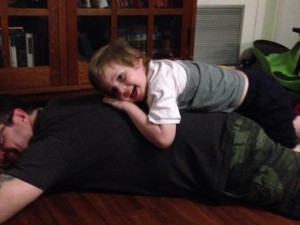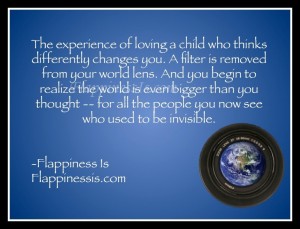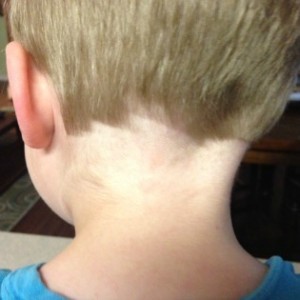A few weeks ago, I was asked if I might be willing to come in and talk to a group of kindergarteners about autism. Of course, this isn’t just any group of kindergarteners. It’s my autistic son’s peers. So, I wanted a read aloud or two, and I wanted them to be good. Being a school librarian, I know that there are an awful lot of children’s books out there. So, I asked the most qualified people I know –my readers — to offer their suggestions on my Facebook page. I got a lot of them.
I couldn’t afford to buy them all, so I ordered several that seemed to fit the age group and read them all in one sitting. No, I didn’t like all of them. I’ve included only the ones here I’m recommending. Simply because I don’t find negative reviews useful to an audience of readers who already have limited time. I tend to shy away from the preachy ones, believing that children are much savvier readers (and listeners) than we give them credit for. And I like books that are a bit subtle and lend themselves to fruitful discussion. Because that’s where you reach hearts and minds.
1. Looking after Louis by Lesley Ely, illustrated by Polly Dunbar
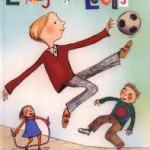 Looking after Louis is the story of a little boy, Louis, who is autistic and is a student in a regular elementary classroom. His friend, an unnamed little girl, narrates the story as she and her classmates try to understand Louis and some of his unusual behaviors. Louis repeats what others say. He colors pictures that others don’t understand. He runs about through the children’s soccer game. Though the children are sweet and generally accepting of Louis, they do begin to notice that Louis is allowed to do some things they aren’t – and point it out. But then a moment comes along in which everyone recognizes Louis’s effort to communicate something special to him. That leads another child to invite Louis to play with him, but it isn’t recess. His teacher, understanding that this is a teachable moment, allows them to go outside with Louis’s aide. The little girl at first resents what she views as special treatment, until her teachers gives her a moment to consider her opinion. Ultimately, she decides that sometimes it’s okay to break rules and expectations for special people – thus supporting the idea of inclusion in the regular classroom. It’s okay that some things are different for students who require it, but everyone can be friends.
Looking after Louis is the story of a little boy, Louis, who is autistic and is a student in a regular elementary classroom. His friend, an unnamed little girl, narrates the story as she and her classmates try to understand Louis and some of his unusual behaviors. Louis repeats what others say. He colors pictures that others don’t understand. He runs about through the children’s soccer game. Though the children are sweet and generally accepting of Louis, they do begin to notice that Louis is allowed to do some things they aren’t – and point it out. But then a moment comes along in which everyone recognizes Louis’s effort to communicate something special to him. That leads another child to invite Louis to play with him, but it isn’t recess. His teacher, understanding that this is a teachable moment, allows them to go outside with Louis’s aide. The little girl at first resents what she views as special treatment, until her teachers gives her a moment to consider her opinion. Ultimately, she decides that sometimes it’s okay to break rules and expectations for special people – thus supporting the idea of inclusion in the regular classroom. It’s okay that some things are different for students who require it, but everyone can be friends.
I really liked this little story, mainly because the range of emotions for these children is honest. At times, they are encouraging of Louis. Sometimes, they are bewildered. And others they are a little resentful of what they view as unfair. However, because of their teacher’s open and accepting handling of Louis, they learn about the true spirit of inclusion. This would make a great read aloud that could lead to a productive conversation about differences. Instead of telling, this book shows what a tolerant and welcoming classroom should look like – a point in its favor and one that distinguishes it from preachier special needs children’s literature. Recommended.
2. Andy and His Yellow Frisbee by Mary Thompson
 Andy and His Yellow Frisbee is the story of Sarah, a new girl at Andy and Rosie’s school. Sarah has noticed Andy, who is autistic, each day at recess, spinning the same yellow Frisbee over and over. She decides to try to connect to Andy by inviting him to spin her pink Frisbee, which she has clearly brought from home in an effort to engage him. Andy’s sister Rosie, playing soccer nearby, faithfully watches over him. She becomes concerned when she sees Sarah sit down next to Andy, knowing that others do not always understand him. She leaves the game and comes over to observe them, seeing Sarah’s gentle effort to interact with Andy and her acceptance that perhaps he’ll choose to do so on another day. Sarah and Rosie decide to play Frisbee together.
Andy and His Yellow Frisbee is the story of Sarah, a new girl at Andy and Rosie’s school. Sarah has noticed Andy, who is autistic, each day at recess, spinning the same yellow Frisbee over and over. She decides to try to connect to Andy by inviting him to spin her pink Frisbee, which she has clearly brought from home in an effort to engage him. Andy’s sister Rosie, playing soccer nearby, faithfully watches over him. She becomes concerned when she sees Sarah sit down next to Andy, knowing that others do not always understand him. She leaves the game and comes over to observe them, seeing Sarah’s gentle effort to interact with Andy and her acceptance that perhaps he’ll choose to do so on another day. Sarah and Rosie decide to play Frisbee together.
I loved this subtle story of acceptance, probably because Sarah reminds me of my daughter. Between Sarah’s effort and Rose’s calm but protective wait-and-see, this story gently conveys to typical children that there is no magic formula for interacting with someone who is autistic. What’s important is to realize that effort does make a difference, even if there isn’t an immediate reward. Andy did notice Sarah’s Frisbee offering, though he continued to play by himself. Sarah’s acceptance of that is beautiful and will serve as a model for typical students wanting to interact with their autistic peers, but unsure of how to do so. Andy and His Yellow Frisbee isn’t what I would choose as a first read aloud when introducing the concept of autism to typical students, because its focus is narrower. But I think it’s ideal as a follow-up later to reinforce lessons on differences and to help students learn to engage with their autistic peers. It is also a lovely story for protective siblings of children on the spectrum. Recommended.
3. Ian’s Walk: A Story about Autism by Laurie Lears, illustrated by Karen Ritz
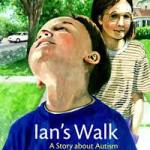 Ian’s Walk is the story of siblings Julie, Tara, and Ian – who is autistic – and their walk to the park. Julie initially doesn’t want Ian to tag along, but gives in when he whines. Her mother admonishes Julie that she must be sure to keep a close eye on Ian. As they head out on their walk, Julie observes the different ways that Ian hears, sees, smells, and feels things. Even though she makes these observations, she finds herself frustrated with the inconveniences of Ian’s differences and loses her patience. When the girls stop to get pizza, Tara reminds Julie to watch Ian. But Julie is distracted and suddenly realizes that Ian has disappeared. The sisters race about, frantic to find their vulnerable little brother. Then Julie focuses and decides to think and experience their surroundings like Ian – where would he be? Sure enough, that’s how she finds him, making the big bell at the park gong back and forth. Julie is so grateful he is safe that she now has a new perspective on their walk back. This time, she allows Ian to enjoy the walk as he wants to experience it, allowing him to stop and immerse himself in the sights, smells, and sensations he loves.
Ian’s Walk is the story of siblings Julie, Tara, and Ian – who is autistic – and their walk to the park. Julie initially doesn’t want Ian to tag along, but gives in when he whines. Her mother admonishes Julie that she must be sure to keep a close eye on Ian. As they head out on their walk, Julie observes the different ways that Ian hears, sees, smells, and feels things. Even though she makes these observations, she finds herself frustrated with the inconveniences of Ian’s differences and loses her patience. When the girls stop to get pizza, Tara reminds Julie to watch Ian. But Julie is distracted and suddenly realizes that Ian has disappeared. The sisters race about, frantic to find their vulnerable little brother. Then Julie focuses and decides to think and experience their surroundings like Ian – where would he be? Sure enough, that’s how she finds him, making the big bell at the park gong back and forth. Julie is so grateful he is safe that she now has a new perspective on their walk back. This time, she allows Ian to enjoy the walk as he wants to experience it, allowing him to stop and immerse himself in the sights, smells, and sensations he loves.
Ian’s Walk is a beautiful story with a simple plot, but one that conveys the complex sibling relationships inherent in special needs families. It’s an obvious story to share with siblings of autistic and special needs children (or even in support groups for such). But because the story also describes so well many aspects of autism and sensory integration disorder, it would also be a great introductory read aloud for the topic. My 7-year-old loved this story and recognized both her brother in the story as well as her own emotions in it. Recommended.
4. My Friend with Autism, Enhanced Edition with CD by Beverly Bishop, illustrated by Craig Bishop
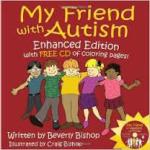 My Friend with Autism isn’t a story so much as a narration by a peer, who tells readers about his friend, who is autistic. It begins with an explanation of all the things his friend is good at – hearing, seeing, touching, tasting, being smart, etc. For each thing his friend is good at comes an explanation of how that affects the friend (examples: extra-sensitive ears that hear before others but cause him to sometimes cover his ears). This part is a positive outlook on autism, but matter-of-fact. There is a shift about halfway through when the narrator explains that – while his friend is good at many things – there are some things that are difficult (talking, understanding feelings, sharing, etc.) What’s good about this part is how the narrator makes suggestions of what can be done to help the friend when these things occur.
My Friend with Autism isn’t a story so much as a narration by a peer, who tells readers about his friend, who is autistic. It begins with an explanation of all the things his friend is good at – hearing, seeing, touching, tasting, being smart, etc. For each thing his friend is good at comes an explanation of how that affects the friend (examples: extra-sensitive ears that hear before others but cause him to sometimes cover his ears). This part is a positive outlook on autism, but matter-of-fact. There is a shift about halfway through when the narrator explains that – while his friend is good at many things – there are some things that are difficult (talking, understanding feelings, sharing, etc.) What’s good about this part is how the narrator makes suggestions of what can be done to help the friend when these things occur.
My Friend with Autism is a practical and positive introduction to autism for typical students. It treats autism as something children shouldn’t worry about and conveys to them that they really can be friends with their autistic classmates. This enhanced edition comes with a guide for adults that includes factual information about autism as well as tips for working with children on the spectrum. The CD includes coloring sheets of pages from the book for children to enjoy after the read aloud. I would suggest this book as a first read aloud for an inclusion classroom to be followed by one or more of the other stories in this list.
If you have shared any of these wonderful books with children or students in your life, please comment below. I’d love to hear from you. 🙂
Note to publishers and authors: I’m happy to update this list over time, should you wish to send me a review copy. I’m interested only in picture books. I simply don’t have the time right now to read and review novels. Send queries to: flappinessis@gmail.com.
Like this:
Like Loading...
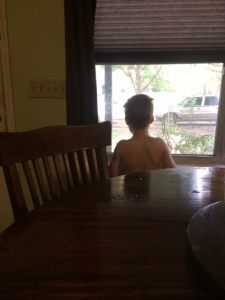 Once upon a time there was an autistic child. He wasn’t “easy.” He didn’t talk like the other children in the family. He didn’t play the same games. He wasn’t interested in going to the same places — hot festivals, toy stores, and noisy restaurants. His family loved him, but he often wasn’t included. He wasn’t invited for sleepovers. He didn’t get the same special outings as his siblings or cousins. Initially, he didn’t notice. But as he grew older, he did. When they came by to pick up his siblings, he wanted to go too. When everyone left without him, he stood at the window and watched them drive away. But his family believed his parents understood– that he was too much to handle.
Once upon a time there was an autistic child. He wasn’t “easy.” He didn’t talk like the other children in the family. He didn’t play the same games. He wasn’t interested in going to the same places — hot festivals, toy stores, and noisy restaurants. His family loved him, but he often wasn’t included. He wasn’t invited for sleepovers. He didn’t get the same special outings as his siblings or cousins. Initially, he didn’t notice. But as he grew older, he did. When they came by to pick up his siblings, he wanted to go too. When everyone left without him, he stood at the window and watched them drive away. But his family believed his parents understood– that he was too much to handle.





